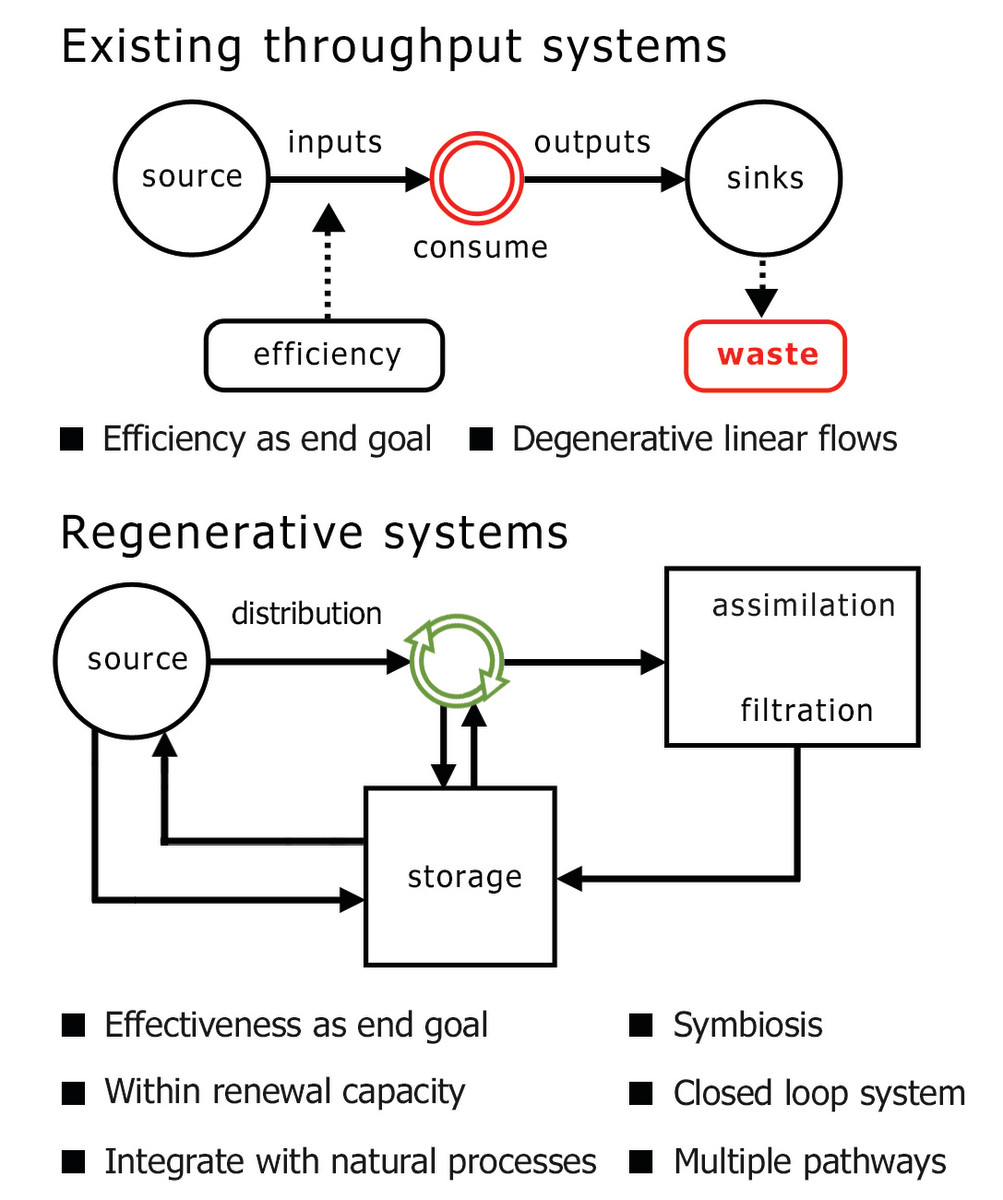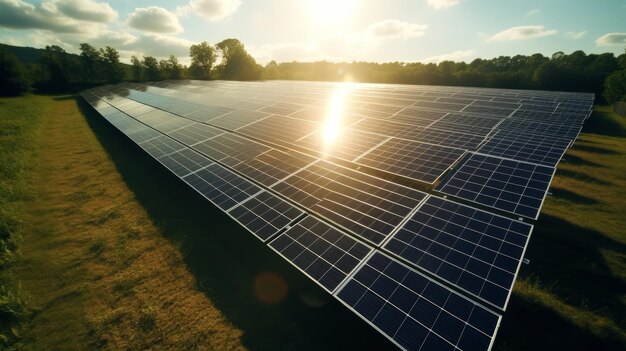
Regenerative Systems: Building Beyond Sustainability for a Thriving Future
For decades, the concept of "sustainability" has been a guiding star for environmentalists, businesses, and policymakers alike. It’s about meeting the needs of the present without compromising the ability of future generations to meet their own needs. It’s about reducing harm, minimizing our footprint, and maintaining the delicate balance of our planet. And while sustainability remains incredibly important, a new, even more ambitious vision is emerging: Regenerative Systems.
Imagine a world where our actions don’t just reduce harm, but actively heal and restore. A world where our economies mimic the efficiency of nature, our buildings clean the air, and our farms rebuild the very soil beneath our feet. This isn’t science fiction; it’s the promise of regenerative systems.
This long-form article will explore what regenerative systems are, how they differ from sustainability, their core principles, real-world examples, and why building beyond sustainability is not just an aspiration, but a vital necessity for a truly thriving future.
Understanding the Foundation: What is Sustainability?
Before we dive into regeneration, let’s briefly revisit sustainability. Think of it as hitting the brakes on a speeding car that’s heading towards a cliff.
Sustainability aims to:
- Reduce Negative Impacts: Less pollution, less waste, less resource depletion.
- Maintain Equilibrium: Keep things stable, prevent further degradation.
- Use Resources Responsibly: Don’t use more than can be naturally replenished.
- Focus on Efficiency: Do more with less.
Examples of Sustainable Practices:
- Recycling
- Using energy-efficient light bulbs
- Reducing water consumption
- Conserving natural habitats
- Developing renewable energy sources (like solar or wind) to reduce fossil fuel use
Sustainability has been a crucial step, shifting our mindset from unbridled consumption to responsible stewardship. However, the critical realization is that "sustaining" a degraded system isn’t enough. If you have a broken leg, "sustaining" it means not breaking it further. But what you really want is to heal it completely, so you can run, jump, and thrive again. This is where regenerative systems come in.
The Evolution: What are Regenerative Systems?
If sustainability is about "doing less bad," regenerative systems are about "doing actively good." They are designed to restore, renew, and revitalize the very systems they interact with, leaving them healthier and more robust than before.
Think of nature itself. A healthy forest doesn’t just "sustain" itself; it regenerates. It builds soil, purifies water, creates biodiversity, and produces abundance. Regenerative systems seek to mimic these natural processes, aiming for a net positive impact.
Key Differences Between Sustainability and Regenerative Systems:
| Feature | Sustainability | Regenerative Systems |
|---|---|---|
| Primary Goal | Minimize harm, maintain current state | Restore, renew, create net positive impact |
| Approach | "Less bad," efficiency, conservation | "Actively good," healing, abundance, co-evolution |
| Mindset | Resource scarcity, risk mitigation | Resource abundance, opportunity, systemic flourishing |
| Output | Neutral or reduced negative impact | Positive, revitalizing impact |
| Analogy | Stopping a leak in a bucket | Filling the bucket while also creating a spring nearby |
Regenerative systems aren’t just about specific technologies or products; they represent a fundamental paradigm shift in how we design, build, produce, and live. It’s about moving from a linear "take-make-waste" model to a circular, living model.
Core Principles of Regenerative Design
Building regenerative systems requires a new way of thinking. Here are some foundational principles:
-
Whole Systems Thinking:
- Concept: Everything is interconnected. You can’t solve problems in isolation. A regenerative approach considers the entire ecosystem – social, economic, and environmental – and how different parts influence each other.
- Example: When designing a building, you don’t just think about energy efficiency (sustainability); you consider how the building impacts local water cycles, soil health, air quality, community well-being, and even the local economy.
-
Mimicking Nature (Biomimicry):
- Concept: Nature has had billions of years to perfect its designs. Regenerative systems learn from these elegant, efficient, and resilient patterns found in ecosystems.
- Example: Designing a material that cleans the air like tree leaves, or creating a water filtration system that imitates a wetland.
-
Net Positive Impact:
- Concept: Go beyond "doing no harm" to actively improving the health and vitality of living systems.
- Example: A farm that not only produces food but also sequesters carbon, enhances biodiversity, and purifies water. A business that creates economic value while also investing in community development and ecological restoration.
-
Co-evolution and Dynamic Equilibrium:
- Concept: Systems are not static; they are constantly evolving. Regenerative design embraces this dynamism, fostering mutually beneficial relationships between humans and nature. It’s about adapting and evolving together.
- Example: A community developing local food systems that adapt to changing climate conditions, fostering new seed varieties and farming techniques in collaboration with the local environment.
-
Place-Based Design:
- Concept: Every place is unique, with its own specific climate, geology, culture, and needs. Regenerative solutions are tailored to the specific context, respecting and enhancing local characteristics.
- Example: Using local materials in construction, designing water management systems that fit the regional rainfall patterns, and cultivating crops best suited to local soil and climate.
-
Empowerment and Participation:
- Concept: Regenerative systems are often driven by community engagement and shared ownership. They foster social equity and empower individuals to be active participants in creating a healthier future.
- Example: Community-led urban gardens, participatory design processes for public spaces, or co-operative business models that distribute benefits widely.
Where Do We See Regenerative Systems in Action?
The regenerative movement is gaining momentum across various sectors. Here are some powerful examples:
1. Regenerative Agriculture
This is perhaps the most well-known application. Unlike conventional farming that often depletes soil and relies heavily on synthetic inputs, regenerative agriculture focuses on:
- Building Soil Health: Through practices like no-till farming, cover cropping, and diverse crop rotations, farmers can increase organic matter in the soil, making it more fertile and better able to hold water.
- Sequestering Carbon: Healthy soil acts as a massive carbon sink, drawing carbon dioxide from the atmosphere.
- Enhancing Biodiversity: Supporting a wider range of plants, insects, and microorganisms above and below ground.
- Improving Water Cycles: Better soil structure allows for greater water infiltration and retention, reducing runoff and improving water quality.
- Examples: Farmers grazing livestock in a way that mimics natural herds (mob grazing), cultivating diverse heirloom crops, and eliminating synthetic pesticides and fertilizers. Brands like Patagonia are investing heavily in regenerative organic cotton.
2. Regenerative Architecture and Urban Design
Moving beyond "green buildings," regenerative architecture aims for buildings and cities that contribute positively to their environment:
- Living Buildings: These are designed to be self-sufficient and net-positive, generating more energy than they consume, capturing and treating their own water, and processing their own waste. They might incorporate living walls, green roofs, and advanced water recycling systems.
- Biomimetic Design: Using natural forms and processes as inspiration. For example, designing a building’s ventilation system to mimic a termite mound’s cooling system.
- Urban Ecosystems: Creating green spaces that clean air, manage stormwater, provide habitat for wildlife, and foster community well-being, turning cities into vibrant, interconnected ecosystems.
- Examples: The Bullitt Center in Seattle (one of the greenest commercial buildings in the world), or urban planning that prioritizes walkable neighborhoods, local food production, and integrated natural water systems.
3. Regenerative Economies
This goes beyond just "sustainable business" to creating economic systems that are inherently restorative and equitable:
- Circular Economy: Moving away from the linear "take-make-dispose" model. Products are designed for durability, reuse, repair, and recycling, ensuring materials flow in continuous loops, minimizing waste.
- Local and Community-Based Economies: Strengthening local supply chains, supporting local businesses, and fostering community wealth building. This reduces transportation emissions and builds resilience.
- Valuing Natural Capital: Recognizing the economic value of healthy ecosystems (e.g., clean water, fertile soil, stable climate) and integrating this into financial decision-making.
- Examples: Companies designing products that can be easily disassembled and their components reused, community-supported agriculture (CSAs), and investment funds focused on regenerative projects.
4. Regenerative Energy Systems
While sustainable energy focuses on clean energy sources, regenerative energy considers the broader impact and integration:
- Distributed Energy Grids: Moving away from large, centralized power plants to smaller, localized renewable energy sources (solar panels on homes, community wind farms) that are more resilient and less vulnerable to disruption.
- Energy Storage Solutions: Integrating advanced battery and other storage technologies to ensure a constant supply of renewable energy, even when the sun isn’t shining or the wind isn’t blowing.
- Smart Grids: Using technology to optimize energy use, reduce waste, and balance supply and demand in real-time.
- Examples: Neighborhoods with microgrids powered by rooftop solar and shared battery storage, or systems that use waste heat from industrial processes for other uses.
5. Regenerative Communities and Social Systems
Regeneration isn’t just about the environment; it’s also about human well-being and social equity:
- Restorative Justice: Approaches to justice that focus on repairing harm and rebuilding relationships, rather than just punishment.
- Trauma-Informed Communities: Creating environments that understand and respond to the impacts of trauma, fostering healing and resilience.
- Participatory Governance: Empowering community members to have a voice in decisions that affect their lives, leading to more equitable and effective outcomes.
- Examples: Community land trusts that ensure affordable housing, co-housing initiatives that build strong social bonds, or local councils that actively involve citizens in urban planning.
Why Go Beyond Sustainability? The Abundant Benefits
The shift to regenerative systems offers a multitude of profound benefits, far exceeding what sustainability alone can achieve:
-
Environmental Restoration:
- Climate Change Mitigation: Regenerative agriculture and healthy ecosystems actively sequester carbon, helping to draw down atmospheric CO2.
- Biodiversity Enhancement: Creating diverse habitats supports thriving plant and animal life, reversing species loss.
- Water Quality and Availability: Healthy soil and natural water management systems filter pollutants and improve water retention, reducing droughts and floods.
- Soil Regeneration: Rebuilding fertile topsoil, which is crucial for food security and ecosystem health.
-
Social Well-being:
- Improved Health: Access to nutrient-dense food, cleaner air and water, and connection to nature contribute to better physical and mental health.
- Stronger Communities: Collaborative, place-based approaches foster social cohesion, equity, and resilience.
- Enhanced Resilience: Systems that mimic nature are more adaptable and better able to withstand shocks, whether from climate change, economic downturns, or social disruptions.
- Meaning and Purpose: Engaging in regenerative work can provide a deep sense of purpose and connection to something larger than oneself.
-
Economic Prosperity:
- New Economic Opportunities: The regenerative transition drives innovation, creates green jobs, and fosters new industries.
- Increased Efficiency and Resource Security: Circular models reduce waste and reliance on virgin materials, leading to cost savings and more stable supply chains.
- Long-Term Value Creation: Investments in natural and social capital yield long-term returns, creating more stable and thriving economies.
- Reduced Externalities: By internalizing environmental and social costs, regenerative systems create more honest and robust economic models.
The Mindset Shift: From Scarcity to Abundance
Perhaps the most challenging, yet crucial, aspect of embracing regenerative systems is the fundamental mindset shift. For too long, our dominant worldview has been one of scarcity – limited resources, competition, and a belief that human progress must come at the expense of nature.
Regenerative thinking flips this on its head. It recognizes that nature is inherently abundant and creative. When we work with natural processes, rather than against them, we unlock immense potential for flourishing. It moves from:
- "Less bad" to "actively good."
- "Taking" to "giving back."
- "Extracting value" to "creating value for all."
- "Compromise" to "synergy."
This shift is about seeing ourselves not as separate from nature, but as an integral part of living systems, with the capacity to be a force for healing and regeneration.
How You Can Be Part of the Regenerative Movement
The transition to regenerative systems won’t happen overnight, but every action counts. Here’s how you can get involved:
- Educate Yourself: Read books, watch documentaries, and follow organizations dedicated to regenerative practices (e.g., The Regenerative Organic Alliance, Ellen MacArthur Foundation, Project Drawdown).
- Support Regenerative Businesses: Seek out brands and products that prioritize regenerative agriculture, circular design, and ethical practices. Look for certifications where available.
- Advocate for Policy Change: Support local and national policies that incentivize regenerative practices in agriculture, energy, and urban planning.
- Start Small at Home:
- Compost your food waste: Turn "waste" into nutrient-rich soil.
- Plant native species: Support local biodiversity in your garden.
- Reduce, Reuse, Repair: Embrace the circular economy in your daily life.
- Conserve water: Use water wisely and consider rainwater harvesting if feasible.
- Engage in Your Community: Join local initiatives, community gardens, or environmental groups. Share your knowledge and enthusiasm with others.
- Rethink Your Investments: Consider investing in companies or funds that align with regenerative principles.
- Shift Your Mindset: Practice gratitude for natural systems, spend time in nature, and consciously shift your perspective from one of scarcity to one of abundance and possibility.
Conclusion: A Future of Flourishing, Not Just Surviving
Regenerative systems offer a powerful and hopeful path forward. They challenge us to move beyond simply sustaining what we have and instead, to actively participate in the grand process of life, healing our planet and ourselves in the process. It’s a vision of a world where human ingenuity is harnessed to mimic nature’s wisdom, where our actions contribute to thriving ecosystems and vibrant communities.
This isn’t just about environmentalism; it’s about building a better, more resilient, and ultimately more joyful future for everyone. By embracing the principles of regeneration, we can shift from merely surviving to truly flourishing, creating a legacy of abundance for generations to come. The time to build beyond sustainability is now.


Post Comment